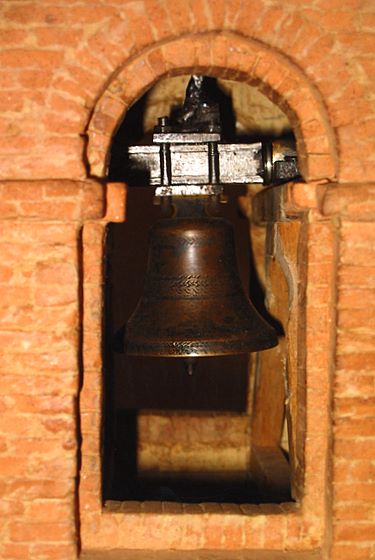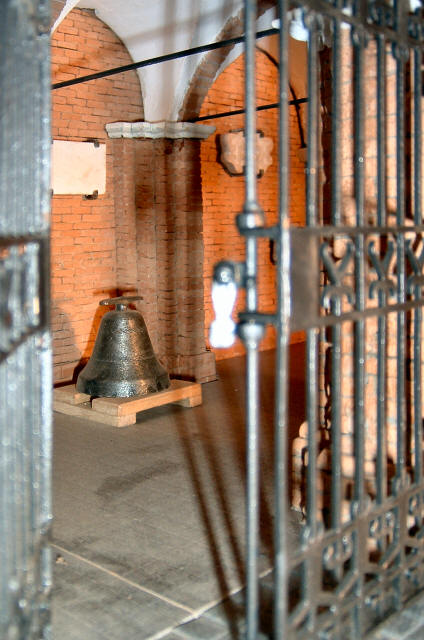Group Project of a Lifetime
by Moreno Bartolucci , Associazione Modellisti Chiaravallessi
Return to Part 2: Every Window Tells a Story
Masonry
The bricks have been applied with Saxite glue used in full-scale construction. Once dried its colour resembles that of the original mortar. Mounting about 200,000 bricks was a time consuming task, requiring also a lot of cutting and grinding. A hand’s skin toll was paid by many of us.
The roof tiles, 38,000 of them, have been applied like the real ones to enable rain water to run down to the drains. The ridges were covered in copper plate, stapled on with copper wires to keep it in situ.
The Bell Tower
The church tower was built as a detachable part to allow access to the bells. The bells, turned in metal, could actually be made to ring because they are motorized, but with their small size they would only be capable of very high notes. So the electric motors are only for the movement, while the voice of the real bells, recorded form the originals, is played back electronically.
Lighting
We have also installed an electronically-controlled 12-volt light system. The interior is lit by sixteen 5W bulbs, accompanied by a dozen external lanterns, all hand-made. Over 50 meters of cable was required to wire all the lamps.
Ironwork
With the walls completed there was a multitude of iron items that had to be added.
Handmade metal bolts and wall bracing reproduced the originals retrofitted during the centuries to counter the effects of time and earthquakes. This factors rend the Abbey very asymmetrical.
On January 17th 1944, heavy bomber raid by USAAF B-25 Mitchells was sent against the railway bridge at Chiaravalle to prevent German reinforcements and supplies being sent the front at Cassino. The raid hit the city very hard, killing about 180 civilians and demolishing the left lateral nave of the church. For the record, none of the bombs hit the bridge and the German trains continued to pass undisturbed.
The beautiful iron fence on the entry portico has been laser cut based on the original design.
Summarizing
This is, in extreme synthesis, the history of 33-month intensive project. During this period, thirteen modellers spent countless hours looking for solutions to several new (at least for us) construction problems. Occasionally there were arguments between us, but we’ll repeat any seconds of the time spent over this fascinating project. At the end our friendship has been reinforced. Indeed, a few months ago we have started a new project, a very different one: the Italian aircraft carrier Garibaldi in 1/72 scale, with the entire complement of AV-8B Plus and helicopter components.
Unfortunately the Model Museum we were looking forward to didn’t materialize. The model, thanks to the city’s municipality, will soon be put on public display in large glass cabinet, under the portico of Santa Maria in Castagnola itself. This way we hope that our effort will be remembered.
For those that want know more about our association, please visit our internet site at www.amc-chiaravalle.org. We also have CDs with many more photos, videos and a more extensive description, but only in Italian language.
The Model in Numbers
- Scale: 1/25
- Overall dimension of the diorama: 3,30 x 1,70 metres.
- Dimension of the church: 2,5 x 1,58 metres, height 1,36 metres
- Weight: ca. 400 kg
- Project effort: around 10.000 man-hours
- Bricks mounted: around 180,000
- Brick dimensions 10x15x4,5 mm
- Roof tiles mounted: around 38,000
- Re-Clay used: 235 kg
- Glue used: 37 kg
- Wood and plywood: 15 sq. m
- Paints, solvents and chemicals: 11 litres
- Aluminium and other metal bars 58 m
- Copper tubes 20 m
- Wires for lights and sounds 52 m
- Internal lamps 5W 12V cc-5°: 16
- External lamps 20W: 12 Vcc 6
- Amplifier: 1
- Mixer: 1, four channels
- Feeder: 1, 12 Vcc – 10°
- CD/Mp3 drive: 1
- Cost of material: 2,600 Euro
This article was originally published in IPMS Stockholms Magazine in June 2007

















